
|
#932 (12/13/21)
Addendum To LOUIS PRIMA - PART ONE

|
Includes an MP4 Video and Audio For Six Songs
(Audio Restored By Dave Saviet - Images Restored By Tony Fournier)
|
THE STORY OF SHIRLEY LLOYD |
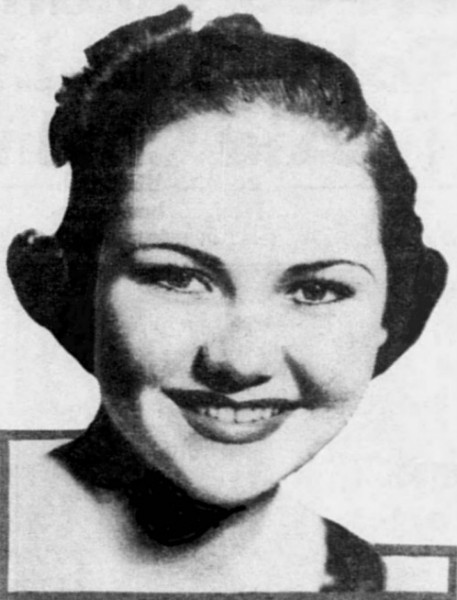
|
Shirley Lloyd, a singer from Colorodo, experienced a meteoric rise to popularity in 1935. She was the featured singer with Herbie Kay's orchestra in 1935 and 1936. Following that, she sang with Ozzie Nelson's dance band in 1936 and 1937. She was immensely popular on radio with both orchestras. Shirley was also an actress, who performed, uncredited, in seventeen movies from 1934 to 1937. In this time period, she did get screen credit for one film short, the 1936 "Give Me Liberty". [Reference: The IMDB Website]
But in early 1938, she fell into a coma for thirty days! Afterward, in mid-1938, Shirley was well enough to make a "comeback" with Louis Prima's orchestra. This resulted in a musical short with Prima in 1938, "Swing Cat's Jamboree" (The video is further down on this page). But her stay with Prima was short. For the following several years, she continued her career, mainly as a club singer, never quite able to achieve her previous heights.
During World War II, Shirley entertained the troops as a member of USO (United Service Organization).
In early 1947, She again joined an orchestra as a featured singer, this time with Sam Donahue's crew, staying with him until early 1949, when his band broke up.
Shirley sang on records released by the Herbie Kay, Ozzie Nelson, and Sam Donahue orchestras.
SHIRLEY LLOYD WITH HERBIE KAY ORCHESTRA:
PARIS NEWS (Texas), June 9, 1935: SHIRLEY LLOYD TO APPEAR WITH HERBIE KAY
Brunette Shirley Lloyd, genial songstress and entertainer, has a type of appeal all her own, according to Herbie Kay, with whose Music Corporation of America she will appear in Paris on June 19. Of medium build with dark hair and eyes, Miss Lloyd has been well received by dancers in the various engagements Kay has played since she joined his 15-piece orchestra some time ago....
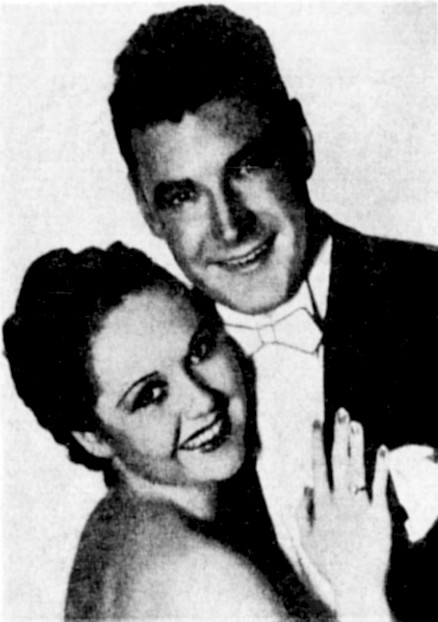 |
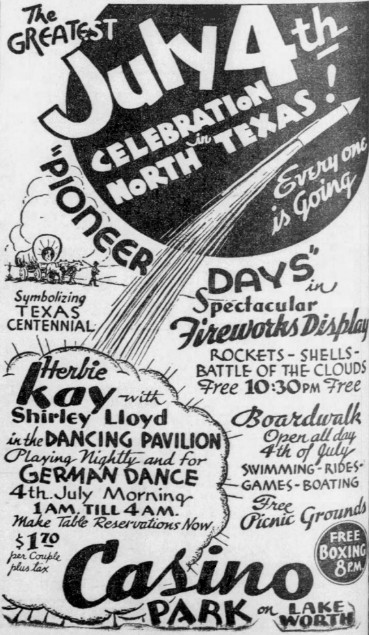
|
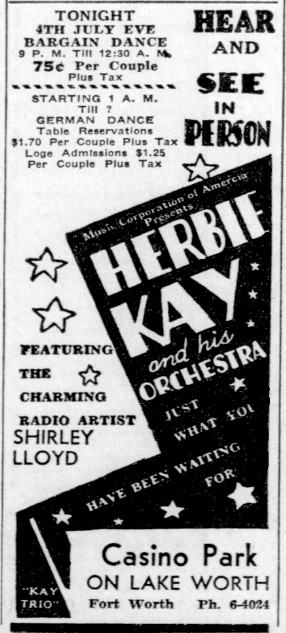
|
Above Left: DES MOINES REGISTER, March 22, 1936.
With a full repertoire of fast-moving orchestra numbers and sizzling hot songs, Herbie Kay, noted band leader, and Shirley Lloyd, famous singer, are coming to Des Moines this week as feature performers at the General Motors show.Above Middle: FORT WORTH STAR TELEGRAM, June 30, 1935.
Above Right: FORT WORTH STAR TELEGRAM, July 3, 1935.
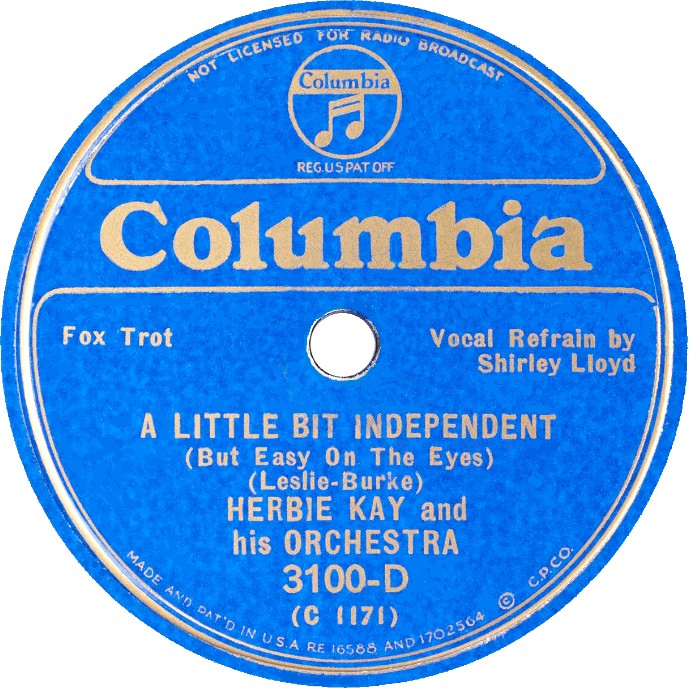
|
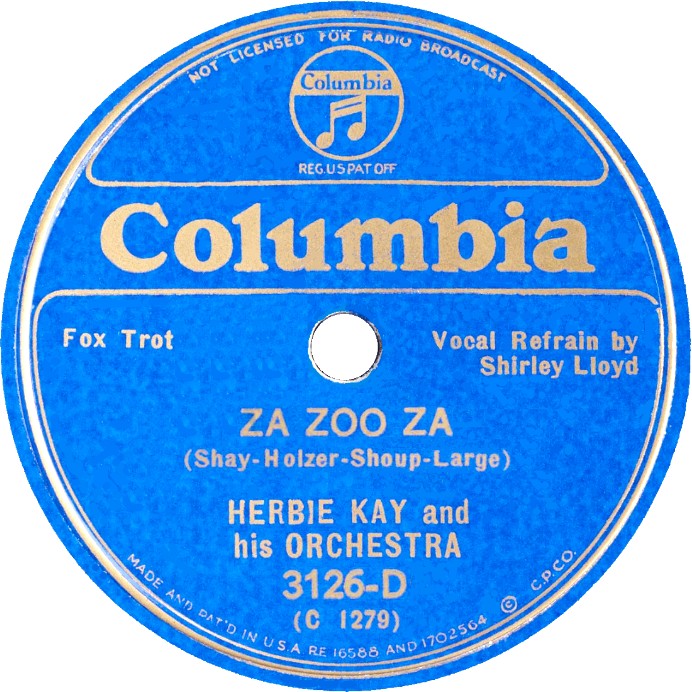
|
Above Left: Label image for Columbia 3100-D, recorded on November 8, 1935 and the record released in 1935. Above Right: Label image for Columbia 3126-D, recorded on February 24, 1936 and the record released in 1936. These seem to be the only two released Columbia records featuring Herbie Kay and Shirley Lloyd. Vocal refrain is by Shirley on one side of each record. Vocal on the flip sides is by Fuzzy Combs.
LISTEN (Windows Media Player): [Audio restoration by Dave Saviet.]
1. "A Little Bit Independent" - Herbie Kay Orchestra, Vocal By Shirley Lloyd - Columbia 3100-D - 1935.
2. "Za Zoo Za" - Herbie Kay Orchestra, Vocal By Shirley Lloyd - Columbia 3126-D - 1936.BOTH SONGS played in sequence.
SHIRLEY LLOYD WITH OZZIE NELSON ORCHESTRA:
NEBRASKA STATE JOURNAL (Lincoln), November 15, 1936:
Pretty Shirley Lloyd, formerly with Herbie Kay's band, is getting a fling at her first big network broadcasts with Ozzie Nelson's orchestra on Bob Ripley's show over the NBC blue network and KOIL Sundays. Shirley was singing over a Chicago station and on CBS sustaining schedules when Ozzie heard her and decided that she belonged on a coast-to-coast broadcast. She is a native of Colorado.
(NOTE: "sustaining" means no commercials.)
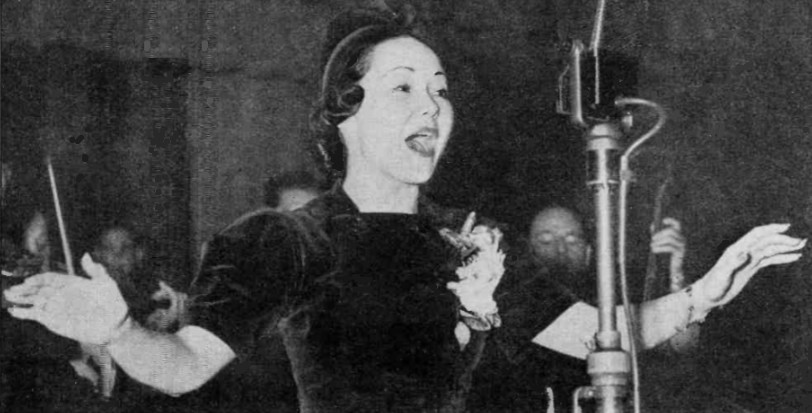
|
Above: RADIO GUIDE, November 21, 1936.
(Shirley Lloyd performing on the radio with Ozzie Nelson's orchestra.)
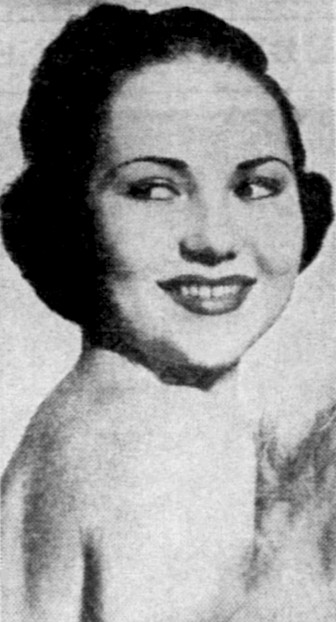 |
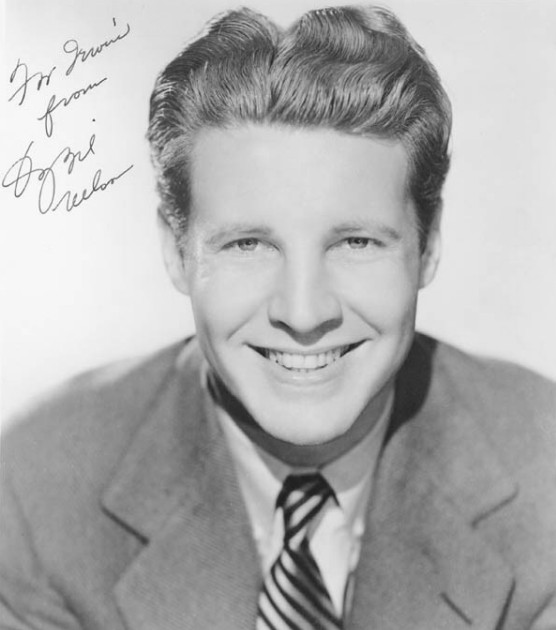
|
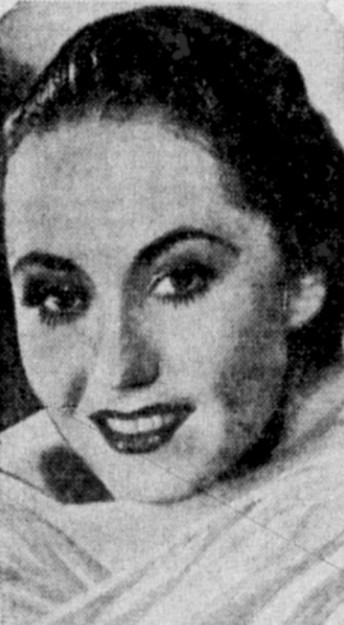
|
Above Left: SOUTH BEND TRIBUNE (Indiana), December 24, 1936:
Shirley Lloyd is the tiny songstress from Pueblo, Colo., who is heard singing with Ozzie Nelson's band on the late evening schedule of WSBT, The South Bend Tribune's broadcasting station.Above Middle: Photo of Ozzie Nelson.
Above Right: MERIDEN RECORD (Connecticut), May 7, 1935: STARS OF RADIOLAND
Although she is only 18, Shirley Lloyd, above, has won a secure niche as a blues singer with a popular dance band in Chicago.
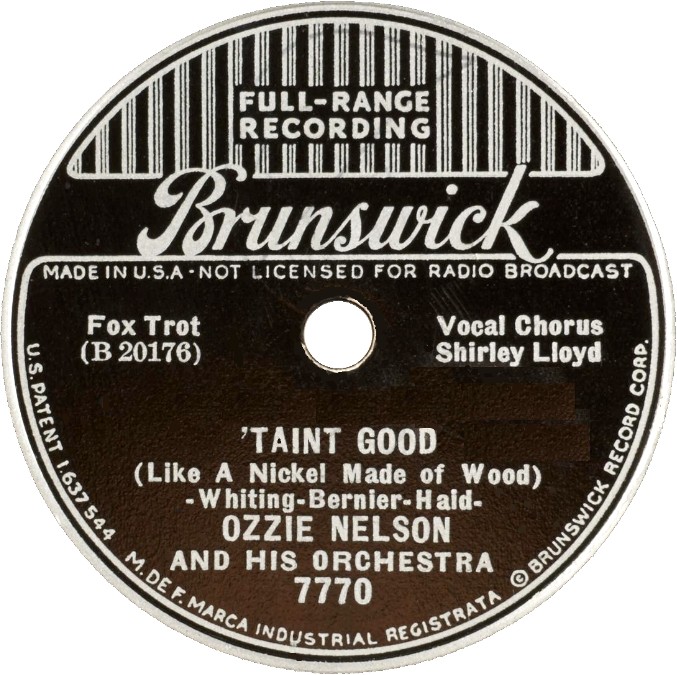
|
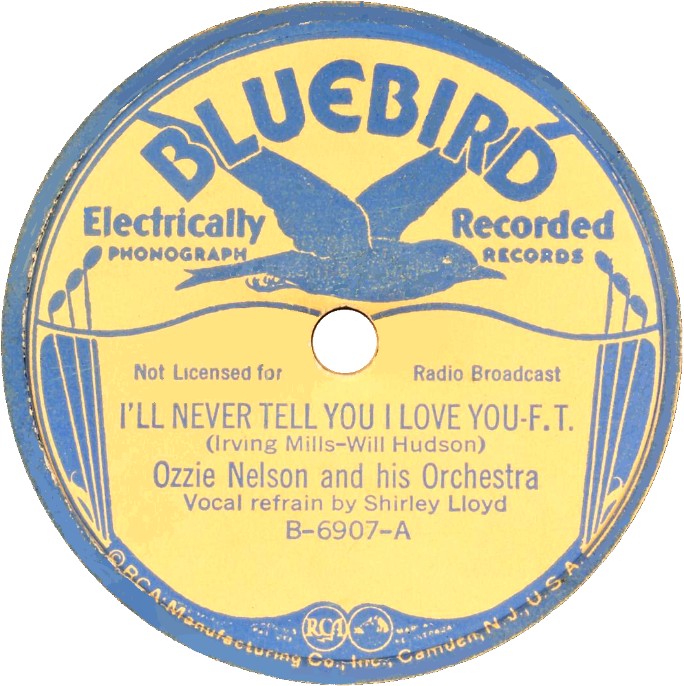
|
Above Left: Label image for Brunswick 7770, recorded on November 2, 1936 and the record released in 1936. Vocal Chorus by Shirley Lloyd. The vocal on the flip side is by Ozzie Nelson. Above Right: Label image for Bluebird B-6907-A, recorded on April 2, 1937 and the record released in 1937. Vocal refrain by Shirley Lloyd. The flip side is an instrumental.
LISTEN (Windows Media Player): [Audio restoration by Dave Saviet.]
1. "'Taint Good" - Ozzie Nelson Orchestra, Vocal By Shirley Lloyd - Brunswick 7770 - 1936.
2. "I'll Never Tell You I Love You" - Ozzie Nelson Orchestra, Vocal By Shirley Lloyd - Bluebird B-6907-A - 1937.BOTH SONGS played in sequence.
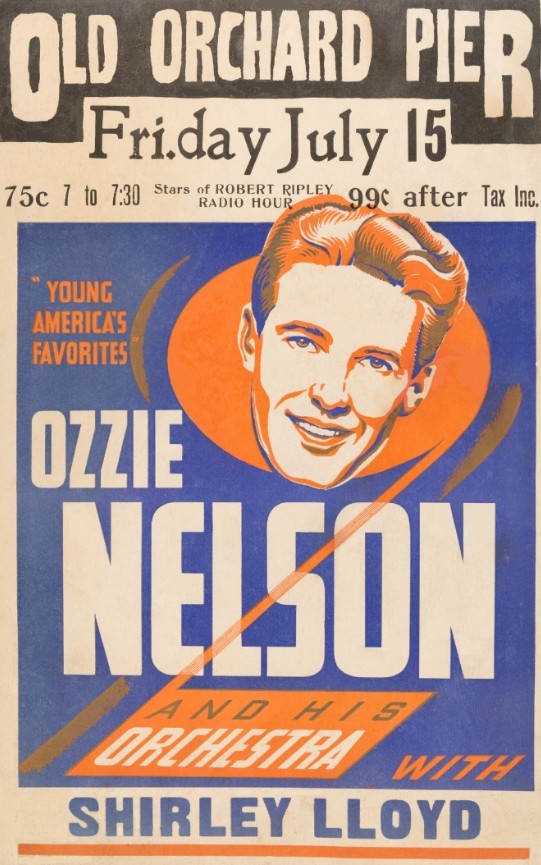
|
SHIRLEY LLOYD FIGHTS FOR HER LIFE:
LOS ANGELES EVENING CITIZEN NEWS (Hollywood, California), April 16, 1938: UNCONCIOUS 11 DAYS, GIRL FIGHTS FOR LIFE
(Actress Attended by Seven Physicians as Malady Proves Baffling)
While a staff of seven physicians pondered her strange case, a beautiful 18 year old actress, Shirley Kuhn, today lays unconscious at the Valley Hospital, Van Nuys.Miss Kuhn, who appears in pictures as Shirley Lloyd, was stricken eleven days ago at her home, 10960 Bluffside Drive, North Hollywood, and has been unconscious since.
The specialists called in on the case said that the girl is suffering from a cerebral hemorrhage, the cause of which they have been unable to determine. She is being given liquid sustenance.
Mrs. Fred Kuhn, mother of the patient, told physicians that she left her daughter at home for a few minutes on April 6 while she went to the store and on her return found the girl unconscious. Earlier the same day, Miss Kuhn had a singing audition at a radio station.
The young blonde [sic, brunette] actress attended private schools in Alhambra [a city in Los Angeles County] and later moved to Hollywood. She was under contract to Warner Brothers Studio for a year, according to her agent, Stetson Davis.
Up till now the girl's life has been free of any illness, her mother said. [Shirley did have an emergency appendicitis operation in 1937.]
MINNEAPOLIS STAR, April 19, 1938: SLEEPING BEAUTY
VAN NUYS, Calif.—Slowly but surely, pretty Shirley Lloyd, 20-year-old actress and singer, was emerging from a strange coma that has gripped her for 12 days. For the first time since April 6, when she was stricken shortly after making a successful radio audition, the movie player roused from her "sleep" sufficiently to say a few words.Miss Lloyd is suffering from an unusual cerebral ailment known as sub-arachnoid hemorrhage. She was stricken returning home from an audition that will give her a job singing on the radio if she recovers with her voice unimpaired.
"She now seems improving", attendants at the Valley Hospital said. "She stirs as though about to awaken from a sleep. She mumbled a few words, and this is encouraging"....
POMONA PROGRESS BULLETIN (Lincoln, Nebraska), May 6, 1938: SHIRLEY LLOYD, COMA VICTIM, RECOVERING
HOLLYWOOD—Shirley Lloyd, 19, film singer who more than a month ago was stricken with a rare malady which caused her to lapse into a coma, was making good recovery today, her doctors reported.For the first time since she was stricken with a sub-arachnoid hemorrhage, she was able to recognize and speak to her mother, Mrs. Fred Kuhn. Doctors predict she will be completely well within another six months.
(NOTE: A subarachnoid hemorrhage, even with today's medical advances, has a mortality rate of 40-50%.)
SEATTLE STAR, May 6, 1938: STRICKEN FILM SINGER BETTER
HOLLYWOOD—Shirley Lloyd, film singer, arousing from a 30-day coma, was able to recognize her mother today, but not her father. As the mother approached her bed, the 19-year-old "sleeping beauty" sat up for the first time since her illness and murmured "mother". She did not, however, recognize her father, Fred Kuhn.The actress, whose real name is Shirley Lloyd Kuhn, was stricken with a subarichnoid hemmorrhage last April 6. Physicians said from three to six months will be required for complete recovery.
SHIRLEY LLOYD WITH LOUIS PRIMA ORCHESTRA:
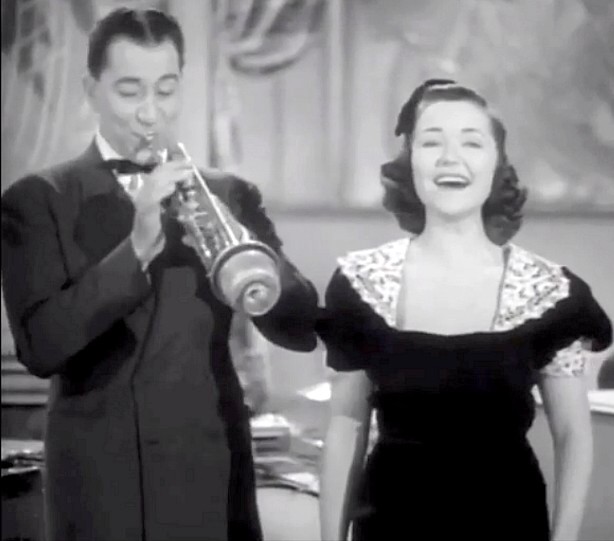
|
Above: A still shot from the 1938 Warner Brothers/Vitaphone movie short "Swing Cat's Jamboree", (L-R) Louis Prima, Shirley Lloyd. This musical film, released in August 1938, features Louis Prima and his quintet of musicians, plus Shirley Lloyd, Ted Gary, and Mitzi Dahl. The music played is hot and jazzy, the dancing is hectic.
There are five song selections:
1. Way Down Yonder In New Orleans - Louis Prima and Quintet (Prima's theme song and home town tribute).
2. I Can't Give You Anything But Love - Louis Prima and Quintet, vocal by Shirley Lloyd.
3. Please Be Kind - Louis Prima and Quintet, vocal by Prima.
4. You're An Education - Louis Prima and Quintet, vocal by Ted Gary, dancing by Ted Gary and Mitzi Dahl.
5. Loch Lomond - Louis Prima and Quintet, vocal by Prima, wild dancing by the night club patrons.WATCH the VIDEO of Louis Prima And His Orchestra performing in "Swing Cat's Jamboree" in MP4 format.
(Will open in a new window)LISTEN TO THE AUDIO ONLY (USING WINDOWS MEDIA PLAYER):
"Swing Cat's Jamboree" - Louis Prima Orchestra With Shirley Lloyd - Vitaphone - 1938.
(NOTE: This is the sound track for the complete movie short. At about 4 minutes in, there is tap dancing.)
SHIRLEY LLOYD WITH SAM DONAHUE ORCHESTRA:
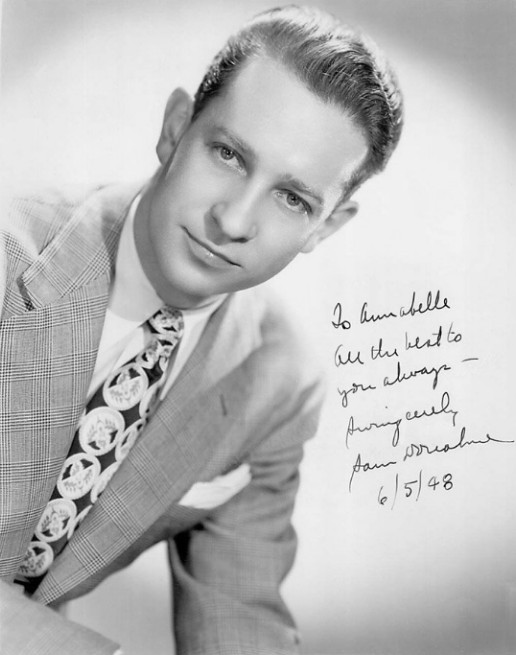
|
Above: Photo from 1948 of Sam Donahue, a saxophonist, trumpeter, composer, arranger, and orchestra leader. Prior to starting his own band, Sam had played with several top-name orchestras.
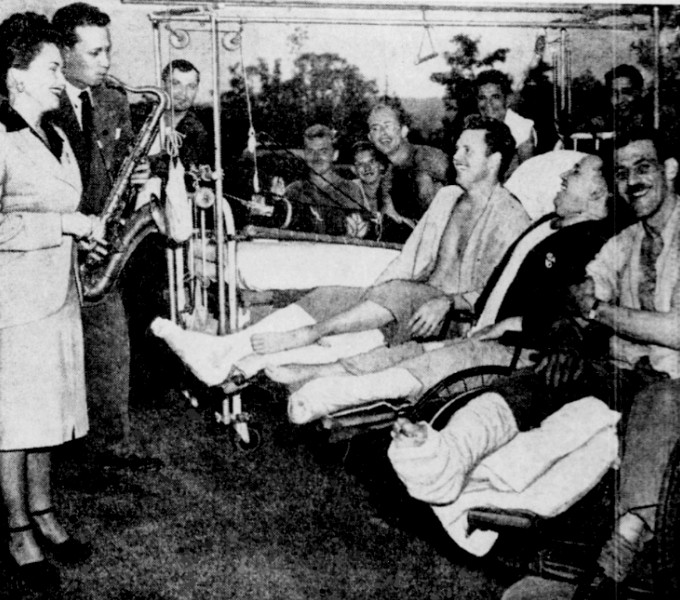
|
Above: PHILADELPHIA INQUIRER, June 9, 1947: GAY INTERLUDE FOR VALLEY FORGE PATIENTS
Sam Donahue (with saxophone), band leader at Click, and Shirley Lloyd, singer, are shown above as they brought laughter to the wounded veterans at Valley Forge General Hospital. The entertainment was arranged by The Philadelphia Inquirer Charities, Inc., in cooperation with Frank Palumbo, restaurateur.
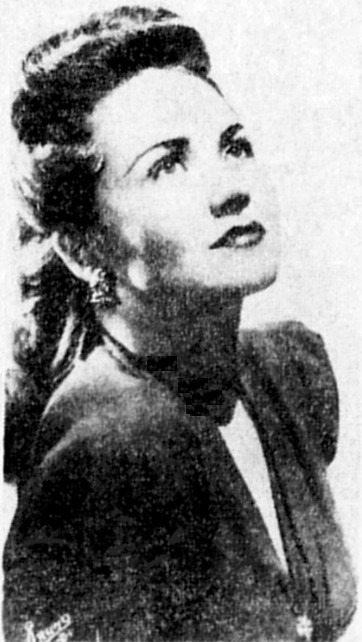 |
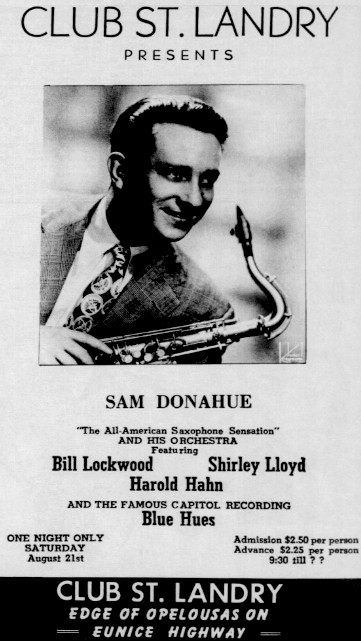
|
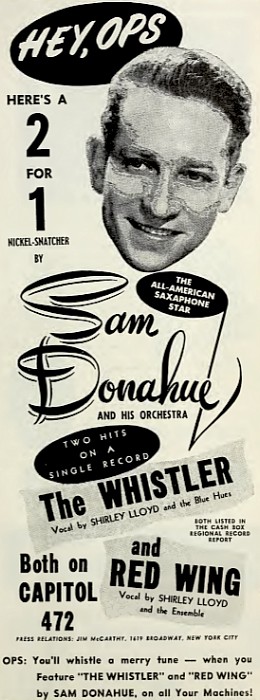 |
Above Left: CINCINNATI ENQUIRER, June 4, 1948: AT CONEY
Shirley Lloyd is the singer with Sam Donahue's Orchestra, which plays a one-night engagement at Coney Island's Moonlite Gardens.Above Middle: DAILY WORLD (Opelousas, Louisiana), August 18, 1948.
Above Right: CASH BOX, December 13, 1947.
(NOTE: "The Whistler" is "Vocal by SHIRLEY LLOYD and the Blue Hues", while the flip is "....and the Ensemble".)DES MOINES REGISTER, February 1, 1948: SAM DONAHUE PLAYS TONIGHT AT TROMAR
A tenor saxophone specialist, Sam Donahue, will lead his orchestra in Tromar Ballroom tonight. Donahue's records include "Six Mile Stretch", "It Counts A Lot" (with Count Basie as guest pianist), "Dinah", "Take Five", and "Red Wing".As an arranger, Donahue's work has been accepted by many of the leading bandsmen. He arranged for the Harry James recording of "Hodge Podge" and Gene Krupa's "Old Mill Stream".
Sam has played for James, Krupa, and Benny Goodman. The orchestra's featured soloist is Shirley Lloyd.
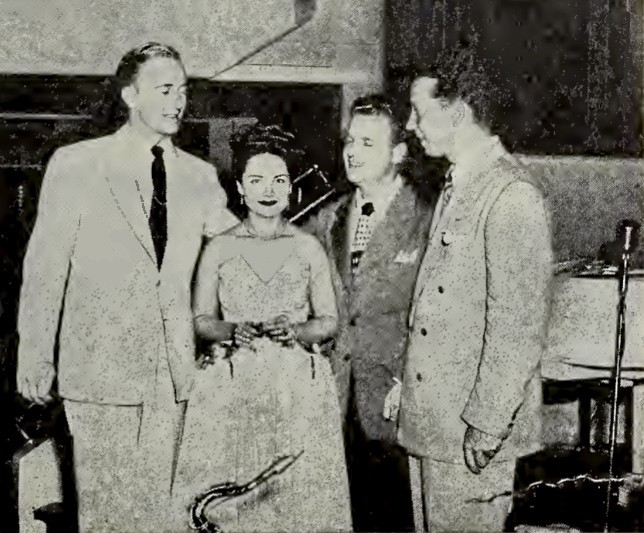
|
Above: CASH BOX, July 24, 1948:
NEW YORK—With sax tootin' maestro Sam Donahue's Capitol platter "Saxo-Boogie" starting to whirl merrily in music boxes throughout the nation, the spotlight beams brilliantly for the young orkster. Sam, currently at the New York Paramount Theatre (his first engagement there) is really tearing the house down.Pictured above, disc jockey Bob Watson of WSB, Atlanta, Ga., congratulates Sam and his vocalists for their wonderful platters. Left to right: Watson, vocalists Shirley Lloyd and Bill Lockwood, and maestro Donahue.
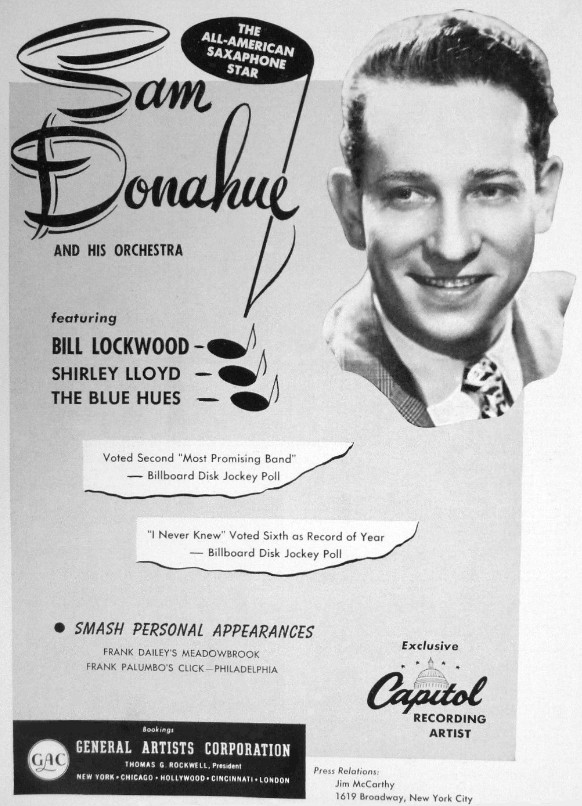
|
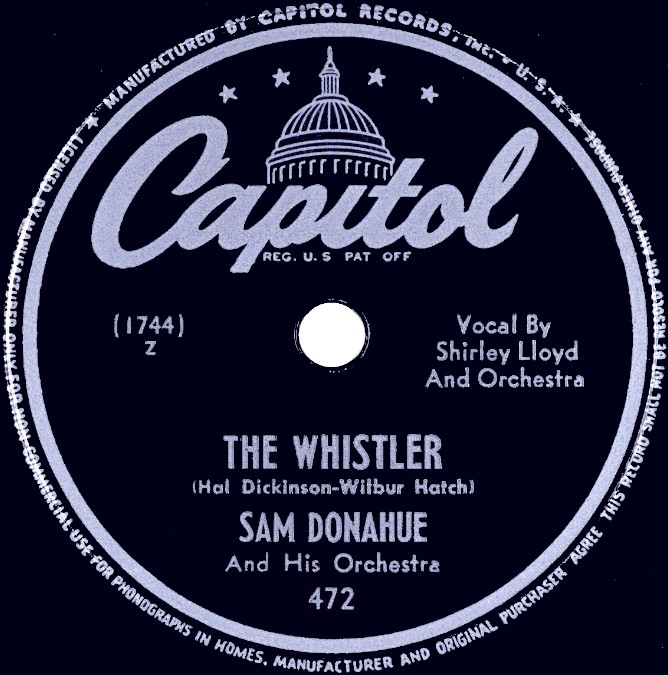
|
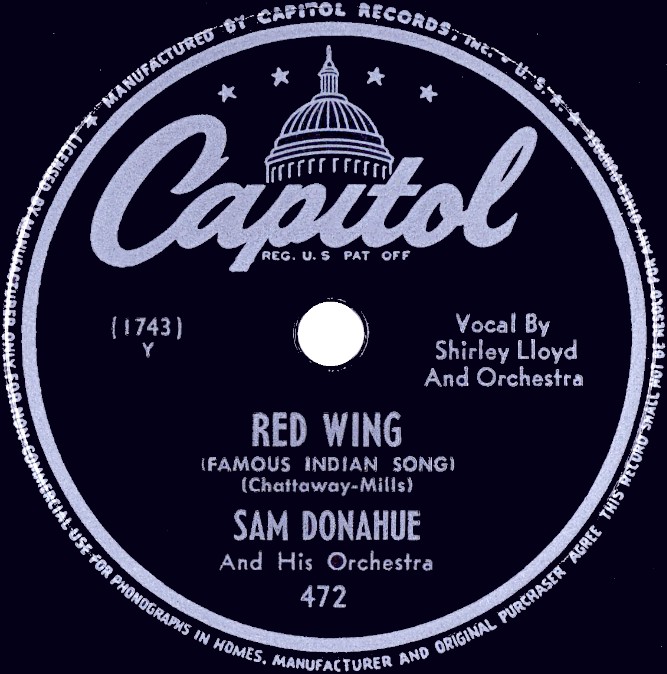
|
Above: Label images for both sides of Capitol 472, recorded on September 9, 1947 and the record released in 1947. Shirley Lloyd is backed vocally by the orchestra on both sides. A blurb about the song "Red Wing" in the Detroit Free Press dated 12/7/47 states "....Shirley (Lloyd) hails from Pueblo, and is part Indian herself...." Donahue and Lloyd had one more record released on Capitol in February 1948.
LISTEN (Windows Media Player): [Audio restoration by Dave Saviet.]
1. "The Whistler" - Sam Donahue Orchestra, Vocal By Shirley Lloyd And Orchestra - Capitol 472 - 1947.
2. "Red Wing" - Sam Donahue Orchestra, Vocal By Shirley Lloyd And Orchestra - Capitol 472 - 1947.BOTH SONGS played in sequence.
MORE ABOUT SHIRLEY LLOYD:
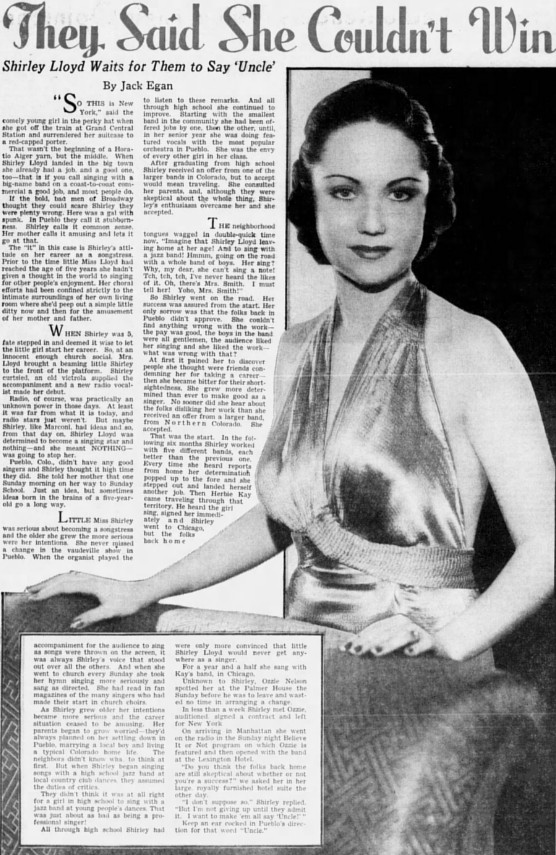
|
Above: ATLANTA CONSTITUTION, April 18, 1937: THEY SAID SHE COULDN'T WIN FULL ARTICLE TEXT:
Shirley Lloyd Waits for Them to Say 'Uncle'... by Jack Egan
"SO THIS is New York," said the comely young girl in the perky hat when she got off the train at Grand Central Station and surrendered her suitcase to a red-capped porter.
That wasn’t the beginning of a Horatio Alger yarn, but the middle. When Shirley Lloyd landed in the big town she already had a job, and a good one, too—that is if you call singing with a big-name band on a coast-to-coast commercial a good job, and most people do.
If the bold, bad men of Broadway thought they could scare Shirley they were plenty wrong. Here was a gal with spunk. In Pueblo they call it stubbornness. Shirley calls it common sense. Her mother calls it amusing and lets it go at that. The "It" in this case is Shirley's attitude on her career as a songstress.
Prior to the time little Miss Lloyd had reached the age of five years she hadn't given a thought in the world to singing for other people's enjoyment. Her choral efforts had been confined strictly to the intimate surroundings of her own living room where she'd peep out a simple little ditty now and then for the amusement of her mother and father.
WHEN Shirley was 5, fate stepped in and deemed it wise to let the little girl start her career. So, at an innocent enough church social, Mrs. Lloyd brought a beaming little Shirley to the front of the platform. Shirley curtsied, an old victrola supplied the accompaniment and a new radio vocalist made her debut. Radio, of course, was practically an unknown power in those days. At least it was far from what it is today, and radio stars just weren't. But maybe Shirley, like Marconi, had ideas and so, from that day on, Shirley Lloyd was determined to become a singing star and nothing—and she meant NOTHING— was going to stop her.
Pueblo, Colo., didn't have any good singers and Shirley thought it high time they did. She told her mother that one Sunday morning on her way to Sunday School. Just an idea, but sometimes ideas born in the brains of a five-year-old go a long way.
LITTLE Miss Shirley was serious about becoming a songstress and the older she grew the more serious were her intentions. She never missed a chance in the vaudeville show in Pueblo. When the organist played the accompaniment for the audience to sing as songs were thrown on the screen, it was always Shirley's voice that stood out over all the others. And when she went to church every Sunday she took her hymn singing more seriously and sang as directed. She had read in fan magazines of the many singers who had made their start in church choirs.
As Shirley grew older her intentions became more serious and the career situation ceased to be amusing. Her parents began to grow worried—they`d always planned on her settling down in Pueblo, marrying a local boy and living a typical Colorado home life.
The neighbors didn't know what to think at first. But when Shirley began singing songs with a high school jazz band at local country club dances they assumed the duties of critics. They didn't think it was at all right for a girl in high school to sing with a jazz band at young people's dances. That was just about as bad as being a professional singer!
All through high school Shirley had to listen to these remarks. And all through high school she continued to improve. Starting with the smallest band in the community she had been offered jobs by one, than the other, until, in her senior year she was doing featured vocals with the most popular orchestra in Pueblo. She was the envy of every other girl in her class.
After graduating from high school Shirley received an offer from one of the larger bands in Colorado, but to accept would mean traveling. She consulted her parents, and, although they were skeptical about the whole thing, Shirley‘s enthusiasm overcame her mother and she accepted.
THE neighborhood tongues wagged in double-quick time now. "Imagine that Shirley Lloyd leaving home at her age! And to sing with a jazz band! Hmmm, going on the road with a whole band of boys. Her sing? Why, my dear, she can't sing a note! Tch, tch, tch, I’ve never heard the likes of it. Oh, there’s Mrs. Smith. I must tell her! Yoho, Mrs. Smith!"
SO Shirley went on the road. Her success was assured from the start. Her only sorrow was that the folks back in Pueblo didn’t approve. She couldn’t find anything wrong with the work—the pay was good, the boys in the band were all gentlemen, the audience liked her singing and she liked the work—what was wrong with that?
At first it pained her to discover people she thought were friends condemning her for taking a career— then she became bitter for their short-sightedness. She grew more determined than ever to make good as a singer. No sooner did she hear about the folks disliking her work than she received an offer from a larger hand, from Northern Colorado. She accepted. That was the start. In the following six months Shirley worked with five different bands, each better than the previous one.
Every time she heard reports from home her determination popped up to the fore and she stepped out and landed herself another job. Then Herbie Kay came traveling through that territory. He heard the girl sing, signed her immediately and Shirley went to Chicago. But the folks back home were only more convinced that little Shirley Lloyd would never get anywhere as a singer. For a year and a half she sang with Kay's band, in Chicago.
Unknown to Shirley, Ozzie Nelson spotted her at the Palmer House the Sunday before he was to leave and wasted no time in arranging a change. In less than a week Shirley met Ozzie, auditioned, signed a contract, and left for New York. On arriving in Manhattan she went on the radio on the Sunday night "Believe It or Not" program on which Ozzie is featured and then opened with the band at the Lexington Hotel.
"Do you think the folks back home are still skeptical about whether or not you're a success?" we asked her in her large, royally furnished hotel suite the other day. "I don‘t suppose so," Shirley replied. "But I'm not giving up until they admit it. I want to make ‘em all say 'Uncle!'" Keep an ear cocked in Pueblo`s direction for that word "Uncle."
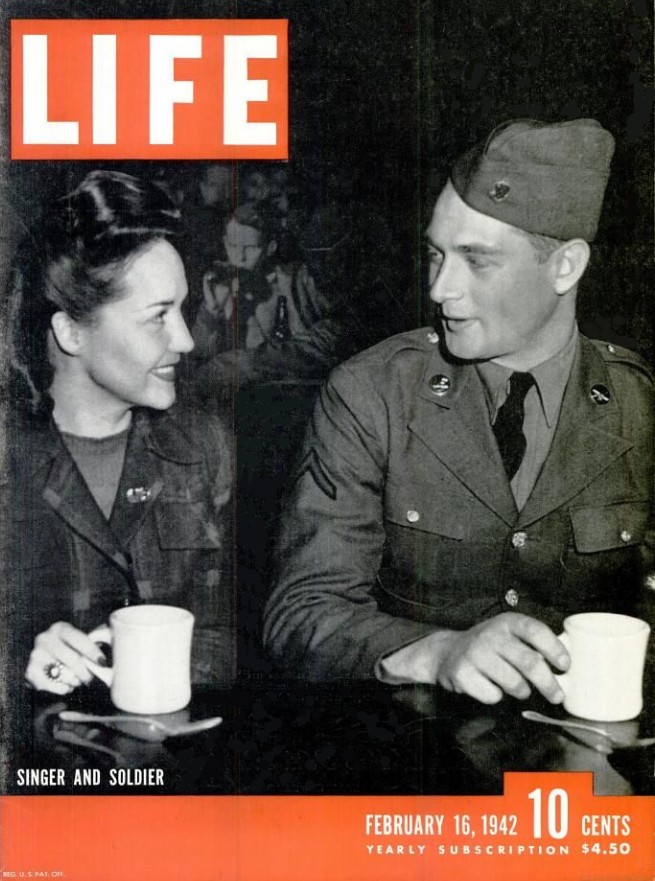
|
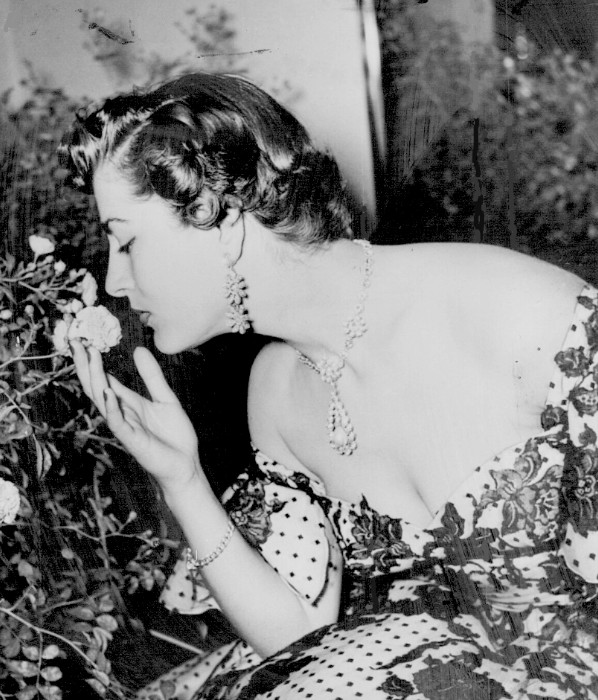
|
NOTE: Above left, on the cover of LIFE Magazine, are Shirley Lloyd and David S. Ingall. During World War II, Shirley entertained the troops as a member of USO (United Service Organization).
Listen to all of this article's audio selections using Windows Media Player:
[Audio restoration by Dave Saviet.]
|
1. "A Little Bit Independent" - Herbie Kay Orchestra, Vocal By Shirley Lloyd - Columbia 3100-D - 1935.
2. "Za Zoo Za" - Herbie Kay Orchestra, Vocal By Shirley Lloyd - Columbia 3126-D - 1936. 3. "'Taint Good" - Ozzie Nelson Orchestra, Vocal By Shirley Lloyd - Brunswick 7770 - 1936. 4. "I'll Never Tell You I Love You" - Ozzie Nelson Orchestra, Vocal By Shirley Lloyd - Bluebird B-6907-A - 1937. 5. "The Whistler" - Sam Donahue Orchestra, Vocal By Shirley Lloyd And Orchestra - Capitol 472 - 1947. 6. "Red Wing" - Sam Donahue Orchestra, Vocal By Shirley Lloyd And Orchestra - Capitol 472 - 1947. ALL SIX ABOVE SONGS played in sequence. |
ADDITIONAL ARTICLES/RECORDS OF THE WEEK!
Back to Main Page
E-mail Me: